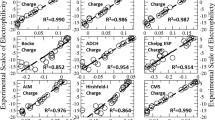Abstract
Comparative calculations based on the use of a homodesmotic reaction (HDR)—an isodesmic process with the additional requirement for group balance—is used to analyze the thermochemical characteristics of cyclic organic compounds exemplified by bicyclo[2.1.0]pentene-2. To avoid confusion in selecting HDRs, an algorithm is developed for determining the HDR basis, i.e., the set of all possible independent homodesmotic reactions. The algorithm for constructing the set of HDRs is based on an analysis and transformations of the bond graph of groups for the investigated chemical compound. The use of graph theory allows us to automate the procedure for deriving the basis of homodesmotic reactions, and to obtain a visual geometric interpretation of the basis, which is important for subsequent physicochemical analysis. The energetics of bicyclo[2.1.0]pentene-2 is investigated using the proposed approach, and the independent basis of HDRs is found to include 19 formal transformations. Standard enthalpies for the test compound and the participants of homodesmotic reactions are calculated using the G3 composite approach. Thermochemical analysis of the obtained data allows us to determine the standard enthalpy of formation of the bicycle (ΔfH° = 336.4 kJ/mol) and value ΔfH° of a number of cyclic and acyclic alkenes and alkadienes that are products of theoretical decomposition of the test compound. The proposed method is shown to be extremely effective in analyzing the effects of nonbonded interactions in the structure of organic molecules. The ring strain energy of the bicycle is calculated or the test compound: ES = 295.2± 2.2 kJ/mol.

Similar content being viewed by others
REFERENCES
W. D. Hehre, R. Ditchfield, L. Radom, and J. A. Pople, J. Am. Chem. Soc. 92, 4796 (1970).
L. Radom, W. D. Hehre, and J. A. Pople, J. Am. Chem. Soc. 93, 289 (1971).
P. George, M. Trachtman, C. W. Bock, and A. M. Brett, Theor. Chim. Acta 38, 121 (1975).
P. George, M. Trachtman, C. W. Bock, and A. M. Brett, Tetrahedron 32, 317 (1976).
P. George, M. Trachtman, C. W. Bock, and A. M. Brett, J. Chem. Soc. Perkin Trans. II, 1222 (1976).
J. D. Dill, A. Greenberg, and J. F. Liebman, J. Am. Chem. Soc. 101, 6814 (1979).
S. M. Bachrach, J. Chem. Educ. 67, 907 (1990).
S. Benson, Thermochemical Kinetics (Wiley, New York, 1968).
V. I. Minkin, Pure Appl. Chem. 71, 1919 (1999).
Int. Union of Pure and Applied Chemistry, Compendium of Chemical Terminology (Gold Book), Version 2.3.3 (2014).
S. E. Wheeler, K. N. Houk, P. v. R. Schleyer, and W. D. Allen, J. Am. Chem. Soc. 131, 2547 (2009).
S. E. Wheeler, WIREs Comput. Mol. Sci. 2, 204 (2012).
S. L. Khursan, Vestn. Bashkir. Univ. 19, 395 (2014).
S. L. Khursan, Russ. J. Phys. Chem. A 76, 405 (2002).
D. S. Shaikhlislamov, M. R. Talipov, and S. L. Khursan, Russ. J. Phys. Chem. A 81, 235 (2007).
S. L. Khursan, Russ. J. Phys. Chem. A 78 (Suppl. 1), 34 (2004).
S. L. Khursan, Kinet. Catal. 57, 159 (2016).
I. Fishtik, J. Phys. Chem., Part A 116, 1854 (2012).
M. D. Wodrich, C. Corminboeuf, and S. E. Wheeler, J. Phys. Chem., Part A 116, 3436 (2012).
I. Fishtik, J. Phys. Chem., Part A 116, 8792 (2012).
M. D. Wodrich, J. F. Gonthier, C. Corminboeuf, and S. E. Wheeler, J. Phys. Chem., Part A 116, 8794 (2012).
S. L. Khursan, A. S. Ismagilova, A. A. Akhmerov, and S. I. Spivak, Russ. J. Phys. Chem. A 90, 796 (2016).
S. L. Khursan, A. S. Ismagilova, and S. I. Spivak, Dokl. Akad. Nauk 474, 454 (2017).
M. J. Frisch, G. W. Trucks, H. B. Schlegel, G. E. Scuseria, M. A. Robb, J. R. Cheeseman, G. Scalmani, V. Barone, B. Mennucci, G. A. Petersson, H. Nakatsuji, M. Caricato, X. Li, H. P. Hratchian, A. F. Izmaylov, et al., Gaussian 09, Rev. C.01 (Gaussian Inc., Wallingford CT, 2009).
A. D. Becke, J. Chem. Phys. 98, 5648 (1993).
C. Lee, W. Yang, and R. G. Parr, Phys. Rev. B 37, 785 (1988).
Y. Zhao and D. G. Truhlar, Theor. Chem. Acc. 120, 215 (2008).
T. H. J. Dunning, J. Chem. Phys. 90, 1007 (1989).
L. A. Curtiss, K. Raghavachari, P. C. Redfern, V. Rassolov, and J. A. Pople, J. Chem. Phys. 109, 7764 (1998).
P. J. Linstrom and W. G. Mallard, NIST Chemistry Webbook, NIST Standard Reference Database Number 69, National Institute of Standards and Technology, Gaithersburg MD. http://webbook.nist.gov. Accessed December 21, 2017.
S. Rayne and K. Forest, J. Chem. Eng. Data 55, 5359 (2010).
ACKNOWLEDGMENTS
We thank the Khimiya shared resource center at the Ufa Institute of Chemistry, Russian Academy of Sciences, for the opportunity to use a supercomputer to perform our quantum-chemical calculations. This work was supported by the Russian Foundation for Basic Research, and by the Government of the Republic of Bashkortostan as part of scientific project no. 17-47-020068, as well as by the Russian Foundation for Basic Research as the part of scientific project no. 18-07-00584A.
Author information
Authors and Affiliations
Corresponding authors
Additional information
Translated by Yu. Modestova
Rights and permissions
About this article
Cite this article
Khursan, S.L., Ismagilova, A.S. & Akhmetyanova, A.I. Determining the Basis of Homodesmotic Reactions of Cyclic Organic Compounds by Means of Graph Theory. Russ. J. Phys. Chem. 92, 1312–1320 (2018). https://doi.org/10.1134/S0036024418070154
Received:
Published:
Issue Date:
DOI: https://doi.org/10.1134/S0036024418070154




